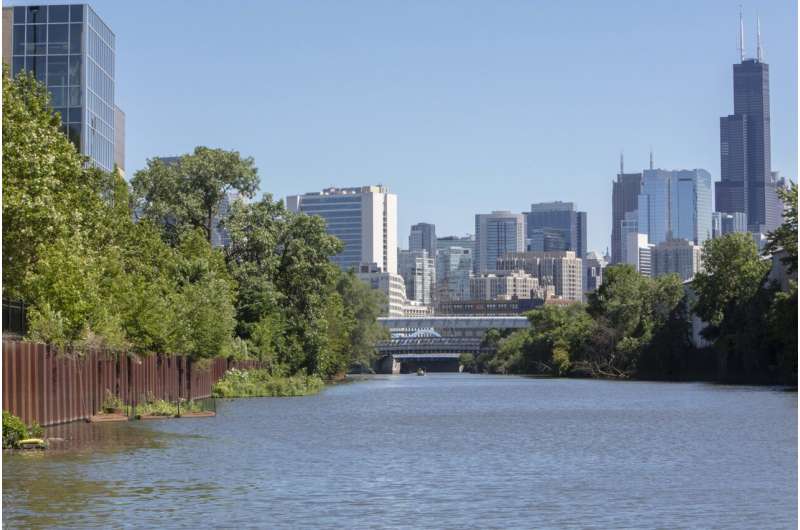This article has been reviewed according to Science X's editorial process and policies. Editors have highlighted the following attributes while ensuring the content's credibility:
fact-checked
proofread
Study shows natural shorelines support greater biodiversity in the Chicago river

New research published today sheds light on the positive effects of maintaining natural shoreline structure on freshwater ecosystems, as opposed to armoring them with steel walls or piles of rocks. The work is published in the journal Aquatic Conservation: Marine and Freshwater Ecosystems.
The study, conducted by Shedd Aquarium, Illinois Department of Natural Resources and Wisconsin Department of Natural Resources, revealed important trends in fish diversity and abundance along various types of shorelines in the Chicago Area Waterway System (CAWS). The findings indicated that both fish species richness and the numbers of fish grew with increasing proportions of natural shoreline.
Shoreline armoring, or the practice of reinforcing shorelines to prevent erosion, is a common alteration to aquatic systems worldwide. However, while its impact on coastal and estuarine environments is extensively studied, research of its effects on freshwater systems has been sparse. To address this gap, the study reviewed data collected during a large-scale, long-term fish survey with a new lens. There was a clear correlation between shoreline type and biodiversity, consistent with those shown in coastal ecosystem studies.
"Our research shows the importance of natural shorelines, which can be functional for both aquatic life and humans," said Dr. Austin Happel, research biologist at Shedd Aquarium. "As urbanization continues to encroach on freshwater systems, reviewing alternatives to armoring, along with restoring or enhancing vegetated space and advocating for policy are all proactive conservation measures to safeguard the health and biodiversity of freshwater ecosystems, which benefits human health, economies, and climate."
One key example the authors point out is that barge traffic is prevalent both in the downtown portion of the Chicago River and the Little Calumet River. However, only the downtown portion exhibits extreme levels of shoreline armoring, while the Little Calumet River sections support relatively high barge traffic without extensively armored shorelines.
The shoreline differences between these two sections are reflected by strong changes to the fish communities. For example, none of the 15 downtown Chicago samples had more than 6 species, whereas 53% of the 336 samples from the Little Calumet River had 10 or more species. The authors use this example to illustrate that extensive barge traffic does not require extensive shoreline armoring, and more natural shore could aid aquatic biodiversity.
Further, particularly of note for the CAWS is the hunting habitat provided by natural sloping shorelines for wading birds like great blue herons (Ardea herodias) and the state-endangered black-crown night-heron (Nycticorax nycticorax). As such, a reduction of steel-walled bulkhead areas in urban waterways, in favor of natural and vegetated shorelines, would increase biodiversity and ecosystem services both within and around the aquatic ecosystem.
In areas where de-armoring is not possible, additions of new habitats or enhancements could also benefit the ecosystem. Floating wetlands with native plants are one example of ways to supplement habitat for aquatic life in urban waterways. Shedd Aquarium has teamed up with local nonprofit Urban Rivers to expand floating habitats on the Wild Mile and in the South Branch of the Chicago River. While any shoreline changes require regulatory reviews from municipal, state and federal agencies, continued novel approaches and innovations for restoration and reducing reliance on armoring provide benefits to aquatic life and people who rely on freshwater systems.
More information: A. Happel et al, Natural shorelines support greater diversity and abundances of fishes than armoured shores along Chicago's waterways, Aquatic Conservation: Marine and Freshwater Ecosystems (2024). DOI: 10.1002/aqc.4158
Provided by Shedd Aquarium



















